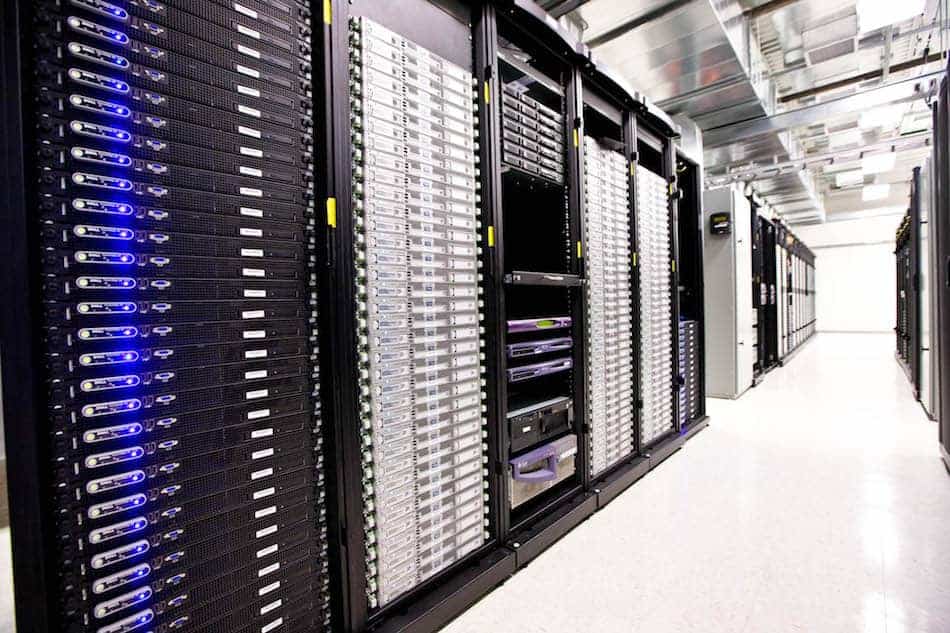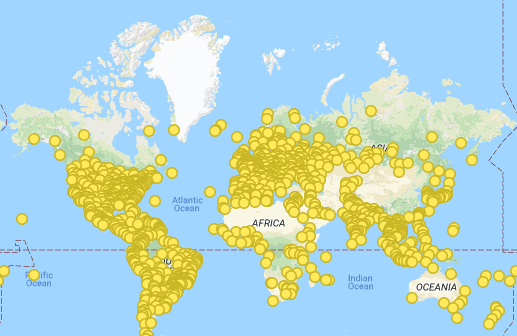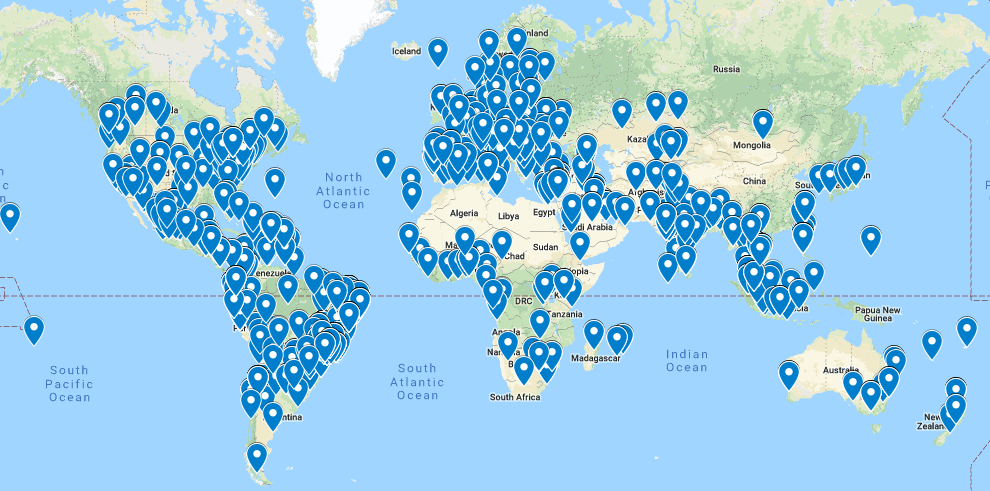Google, Facebook, and Other Tech Giants Are Quietly Buying Up the Most Important Part of the Internet
Fast Facts:
- Google owns major shares of 63,605 miles of submarine cables.
- Google will be the sole owner of 10,433 miles of submarine cables when the Curie cable is completed in 2019.
- Google holds partial ownership of 8.5% of submarine cables worldwide.
- Google holds sole ownership of 1.4% of submarine cables worldwide.
- A boom in submarine cable investments has been underway since 2016.
- Content providers like Facebook and Amazon are increasingly building private cables to support their cloud services.
Disclaimer
Note that this report is focused on cables listed by Telegeography’s open cable data as wholly or partly owned. We have ommited a number of cables where a content provider may be a major capacity buyer or own individual pairs as a smaller stakeholder. Specifically, Microsoft owns pairs (part ownership) on GTT North, GTT Express, and a number of other cables. As a result, some graphics below under-represent Microsoft’s cable ownership.
Google makes billions from their cloud platform. Now they’re using those billions to buy up the internet itself — or at least, the submarine cables that make up the Internet backbone.
If you want to measure the internet in miles, fiber-optic submarine cables are the place to start. These unassuming cables crisscross the ocean floor worldwide, carrying 95–99% of international data over bundles of fiber-optic fibers barely the diameter of a garden hose. All told, there are more than 700,000 miles of submarine cables in use today.
Historically, cables are owned by groups of private companies — mostly telecom providers.
That’s beginning to change. 2016 saw the start of a massive submarine cable boom, and this time, the buyers are content providers — corporations like Facebook, Google, and Amazon.
| Content Providers | Cable Miles Owned | Cable Kilometers Owned |
|---|---|---|
| 63605 | 102362 | |
| 57079 | 91859 | |
| Amazon | 18987 | 30557 |
| Microsoft | 4,104 | 6,605 |

Past cable builders leveraged cable ownership to sell bandwidth, but content providers are building purposefully private cables. Google has financed entire cables, making it one of the first companies to build a private submarine line.
As of the Curie Cable’s completion in 2019, Google owns 1.4% of submarine cables worldwide, as measured by length. If you include cables with shared ownership, Google’s share is closer to 8.5%.
The Internet is commonly described as a cloud. In reality, it’s a series of wet, fragile tubes. And Google is about to own an alarming amount of them.
Google Submarine Cable Ownership
| Provider | Cable name | Ownership | Length in km |
|---|---|---|---|
| Junior | Sole owner | 390 | |
| Tannat | Part owner | 2,000 | |
| Hong Kong-Guam (HK-G) | Part owner | 3,900 | |
| INDIGO-West | Part owner | 4,600 | |
| INDIGO-Central | Part owner | 4,850 | |
| Dunant | Sole owner | 6,400 | |
| Havfrue | Part owner | 7,200 | |
| Southeast Asia Japan Cable (SJC) | Part owner | 8,900 | |
| Japan-Guam-Australia South (JGA-S) | Part owner | 9,500 | |
| Unity | Part owner | 9,620 | |
| Curie | Sole owner | 10,000 | |
| Monet | Part owner | 10,556 | |
| FASTER | Part owner | 11,629 | |
| Pacific Light Cable Network (PLCN) | Part owner | 12,817 |
When the Curie cable is completed in 2019, Google will own 10,433 miles of submarine cables internationally, and a total of 63,605 miles when you include cables they own in consortium with other corporations like Facebook, Microsoft, and Amazon.
Including part-owned cables, Google has enough submarine cables to wrap around the earth’s equator two and half times. (With thousands of cable miles to spare).
2018–2019 is a high growth period for Google’s cloud services. In addition to major submarine cable projects, Google added points of “edge” presence for their cloud platform in Hong Kong, Los Angeles, Finland, and the Netherlands.
In addition to cable operations, Alphabet company Google Fiber has built residential fiber service covering dozens of US markets. Top areas served by Google Fiber are in competitive markets with other internet providers like Salt Lake City, Austin and Kansas City. Among all internet providers in Atlanta, Google Fiber has the 2nd most fiber coverage. Among fiber providers in Irvine, CA, Google Fiber has the 2nd most coverage.
Facebook Submarine Cable Ownership
| Submarine Cables owned by Facebook | Ownership | Length |
|---|---|---|
| MAREA | Part owner | 6,605 |
| Havfrue | Part owner | 7,200 |
| Asia Pacific Gateway (APG) | Part owner | 10,400 |
| Southeast Asia-Japan Cable 2 (SJC2) | Part owner | 10,500 |
| Pacific Light Cable Network (PLCN) | Part owner | 12,817 |
| Hong Kong-Americas (HKA) | Part owner | 13,780 |
| JUPITER | Part owner | 14,557 |
| Bay to Bay Express (BtoBE) Cable System | Part owner | 16,000 |
Facebook’s biggest submarine project is the JUPITER cable from the US to Asia, which is being constructed as a partnership with Amazon. Assuming that cables follow cloud markets, it’s fair to assume that Facebook and Amazon see a big future in providing services in Asia.
Amazon Submarine Cable Ownership
| Submarine Cables owned by Amazon | Ownership | Length |
|---|---|---|
| Bay to Bay Express (BtoBE) Cable System | Part owner | 16,000 |
| JUPITER | Part owner | 14,557 |
Amazon has relatively few submarine cable projects compared to Facebook and Google. All of their cable projects including capacity purchases run from the US to Asia — mainly connecting Japan, Singapore, Oregon, and California.
Microsoft Submarine Cable Ownership
| Submarine Cables owned by Microsoft | Ownership | Length in km |
|---|---|---|
| MAREA | Part owner | 6,605 |
Microsoft buys a high volume of capacity on submarine cables, but at the time of our original report was only listed by Telegeography as holding ownership of one: the MAREA cable running from Virginia in the USA to Bilbao in Spain. As of 2019, it’s been brought to our attention that Microsoft also owns fiber pairs on GTT North, GTT Express (Foundational Customer), AEC1, and is involved with the NCP Consortium (lead and landing party for the asset in the US) (Pacific City, OR).
BroadbandNow would like to thank David J Crowley at Birch Infrastructure who provided extremely helpful commentary on this article and helped improve the accuracy of the report.
Content and Cloud Demand is the Driver Behind Google and Facebook Submarine Projects
Fast Facts:
- Global demand for submarine cable bandwidth grew 52% in 2017, to 689 Tbps of total capacity.
- Since 2003, content provider bandwidth use has risen from effectively zero to 339 Tbps.
- Google is the only content provider with sole ownership of submarine cables.
The submarine cable boom among content providers makes more sense when you look at the growth of traffic that’s taken place in the past decade.
In the Atlantic and Pacific, content providers accounted for over half of total demand in 2017. Content provider data use has skyrocketed from less 8% to near 40% in the past ten years.
It should be noted here that stats are significantly lower in Africa and the Middle East, suggesting that developed nations hunger for video content and cloud apps are a driver of the trend. This is supported by overall international bandwidth use between countries. In 2017, India only used 4,977 Mbps of international bandwidth. The USA used 4,960,388 Mbps in 2017. ref

This also explains why content providers aren’t focussing on routes that are expensive to rent. 10 Gbps unprotected wavelength on a cable from California to Tokyo will cost only ~$5000/month. The same service from California to Australia will cost around ~$26,000. In spite of this difference, providers are focusing on already affordable routes like US to Japan — presumably to support business expansion objectives in Asia. (And well-timed with Google’s censured entry into the China market.)
Why Don’t Streaming Services Like Netflix Invest in Submarine Cables?
On the surface, it makes sense for Netflix to invest in the submarine cable boom, just like the other big content providers. After all, Netflix accounts for a staggering 37% of US Internet traffic and has 130 Million subscribers internationally.
But as it stands, Netflix doesn’t own any cables, and doesn’t have any public plans of doing so.
Instead, Netflix and similar video providers have been investing in a different type of privatized infrastructure: so-called edge networks or CDNs (Content Delivery Networks), which reduce the strain on server-to-user submarine traffic.

The secret to Netflix’s strategy is in the type of content they deliver: one-way static video. Unlike YouTube, Netflix’s video library doesn’t change every minute, and they can effectively predict what customers will request.
This allows Netflix to “queue up” content on edge servers near their customers. Then, when content is requested, it’s quickly delivered over that shorter distance — submarine cables not required. There’s no rush for them to “queue up” content on the edge, and surges in viewership will almost always happen in predictable patterns e.g. when a new season of Stranger Things is released.
An interesting analysis by Alan Mauldin of Telegeography points out that even if every person in the UK watched Netflix at the same time, it would use only 17.3 Tbps of bandwidth. That’s more than enough data to justify cable ownership for a company that can’t predict user habits — but an amount that could be easily distributed via local edge PoPs in predictable events like TV show releases.
Mauldin also points out that if Netflix’s library size is around 190,000 GB, it only takes 6,333 GB daily to refresh their global cache over the course of a month. This small amount of bandwidth is much easier to lease than invest in building from scratch.
The Rise of CDNs and Private Networks
In some ways, buying of cables is just extension of the privatization that’s been going on locally ever since Netflix took off. Providers like Netflix, Youtube, etc, can’t possibly transmit all their data over the public Internet, so they cache (store) content that’s likely to be requested in private boxes in data centers near users.
User habits are getting more and more predictable, at the same time as analytics software gets more and more insightful. This allows providers to pre-empt customer requests and already be “outside the door” when a customer requests the latest trending video or TV show. Of course, this applies to the use of cloud applications as well.
Curious about domestic internet access in the United States?
- Compare all 50 states rank for internet access, pricing, and speeds. You can also view stats for individual states such as New York, California, and Texas.
- Find every internet provider in any zip code, or explore all internet providers in a major city like Dallas.
- Find current pricing, packages and deals for internet service from Xfinity, Spectrum, or Cox, or see a directory of all providers.
The “Flattening” of the Internet: Content Provider Edge Network Investements
To get an idea of how “flat” the Internet really is with so many privately owned CDNs, take a look at these maps published by content providers themselves. Virtually all of these pins have been added in the past ten years.
Here are Google’s edge nodes, used to deliver content as close to users as possible:

Netflix also has a huge edge presence, which makes sense given that delivering static video content is their business model:

Private research suggests that Facebook’s CDN is also sizable:

The Big Picture: Privatized Infrastructure Delivers Faster, Cheaper Service… At A Cost
Like the removal of Net Neutrality, privatizing Internet infrastructure has only reduced prices for consumers. The problem is the moral side: do we want a private Internet? Or do we want to preserve the “Wild West” neutral Internet?
Unfortunately, the question isn’t as simple as drawing a line between “good” and “bad” network optimizations. Practices like edge networking and zero-rating are critical to the business models of companies like Netflix and AT&T — even though these practices don’t technically violate the rules, and ultimately deliver much better services to consumers.

